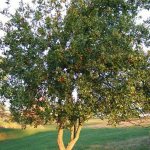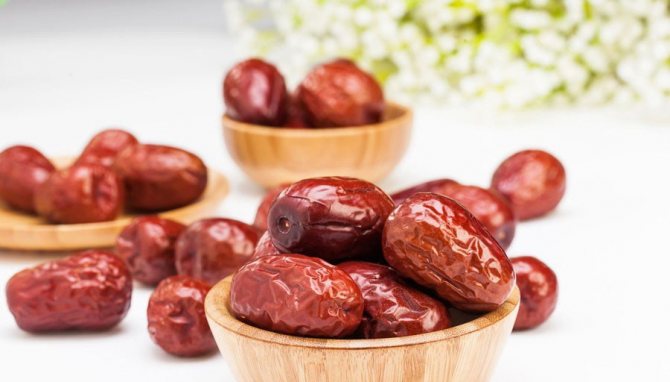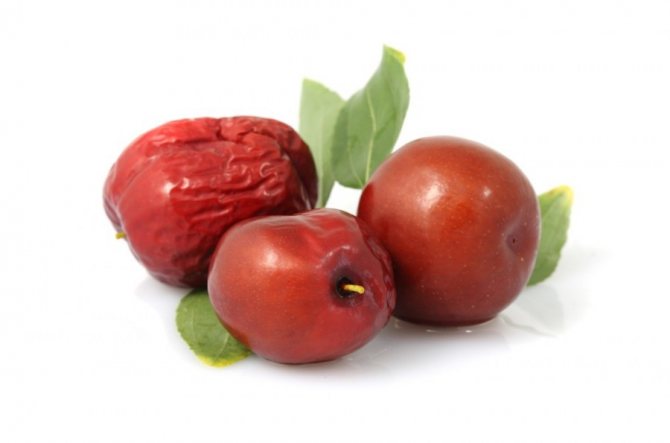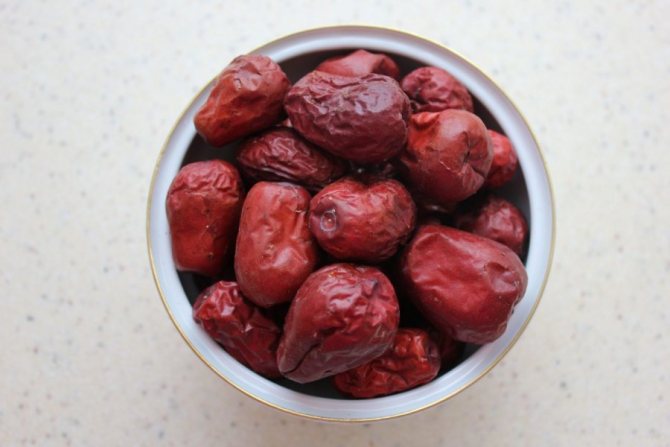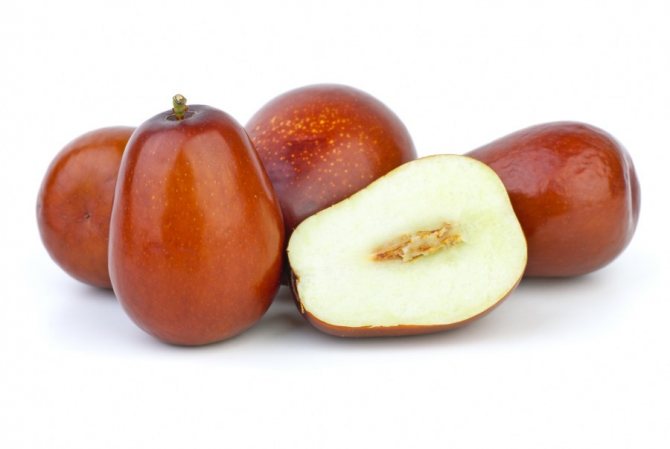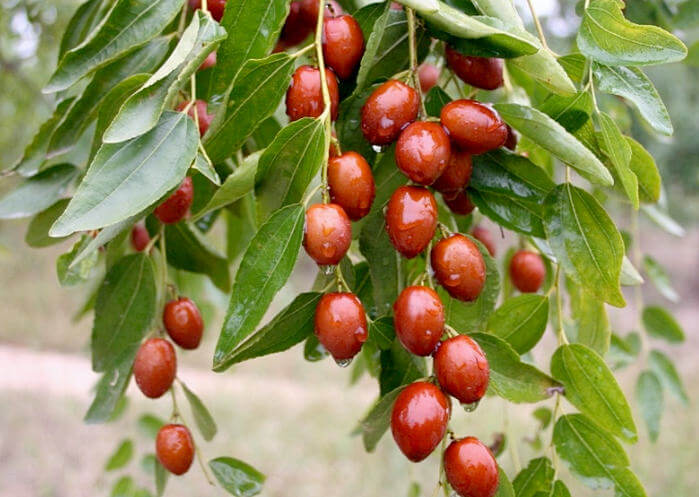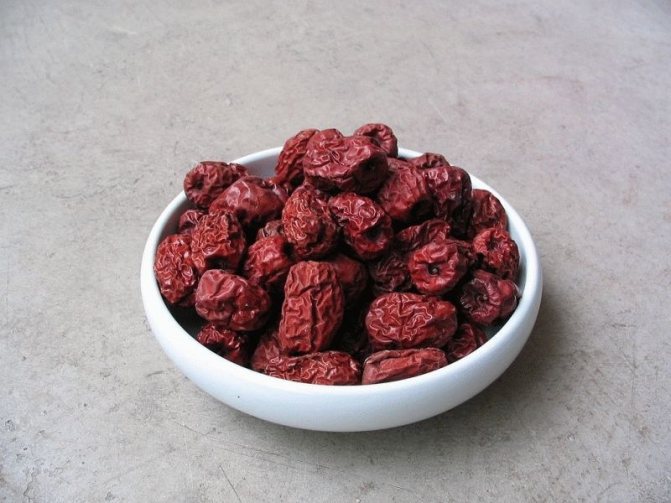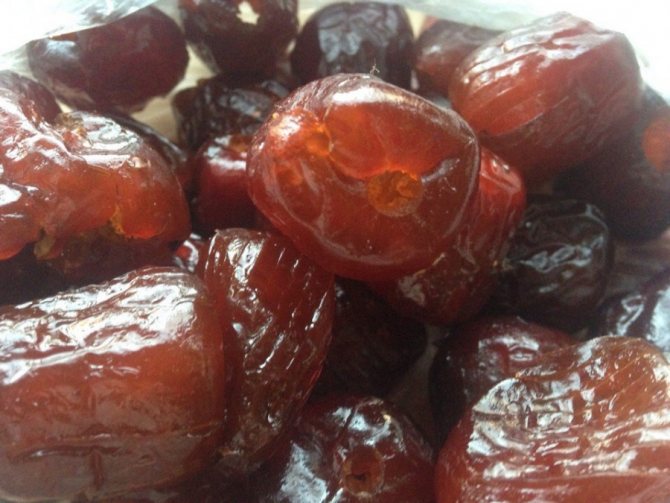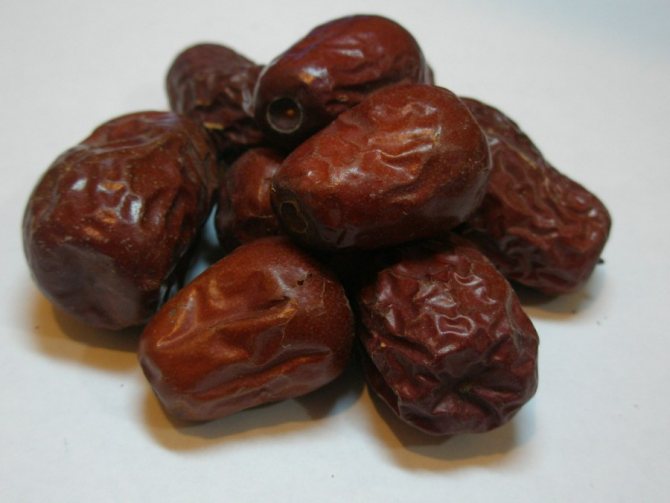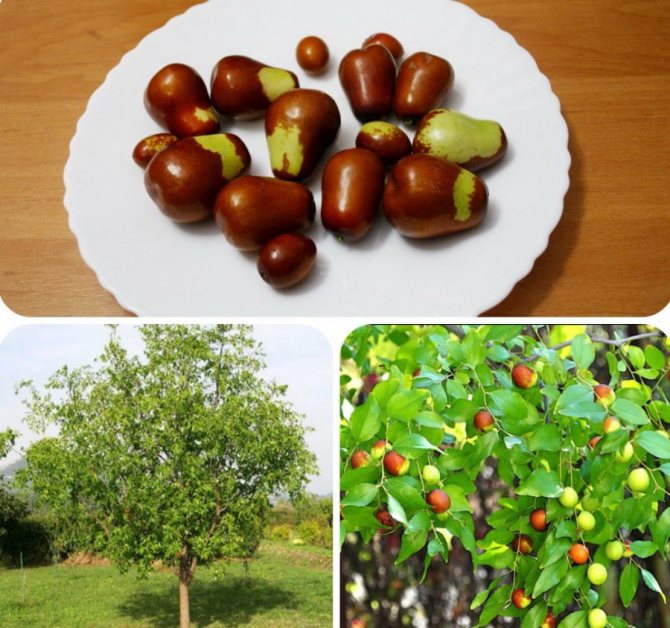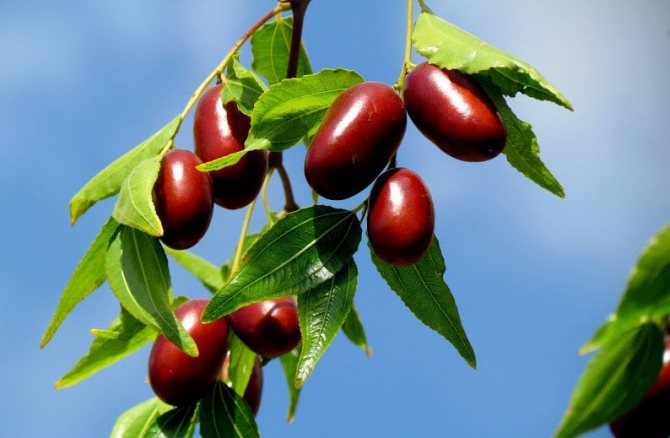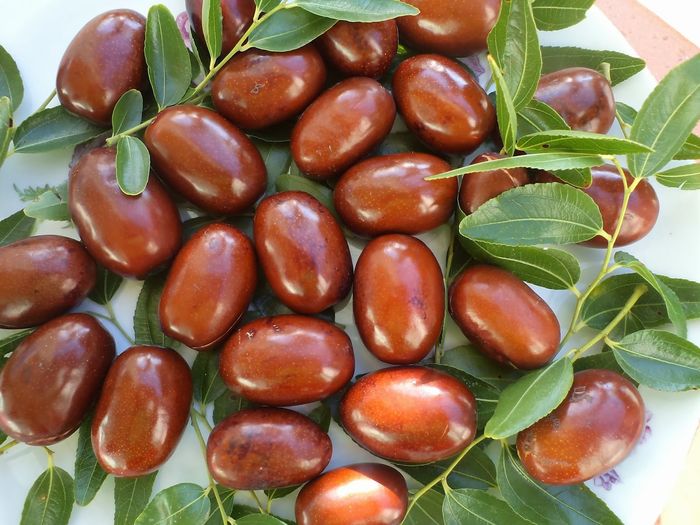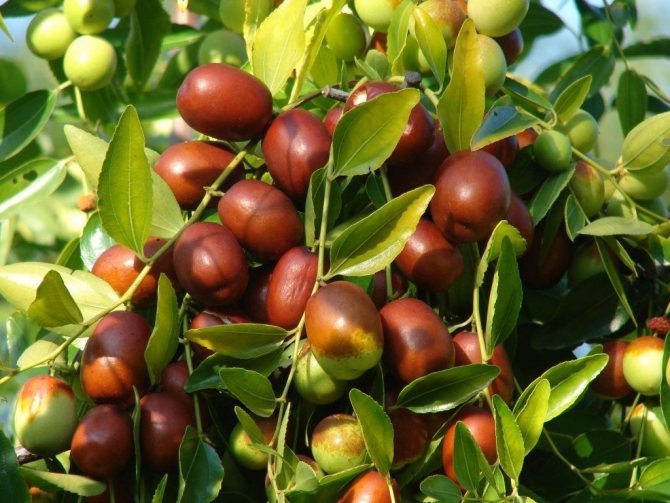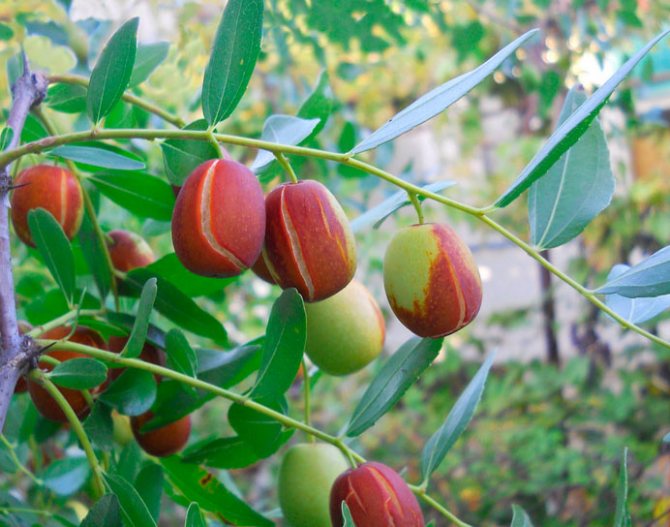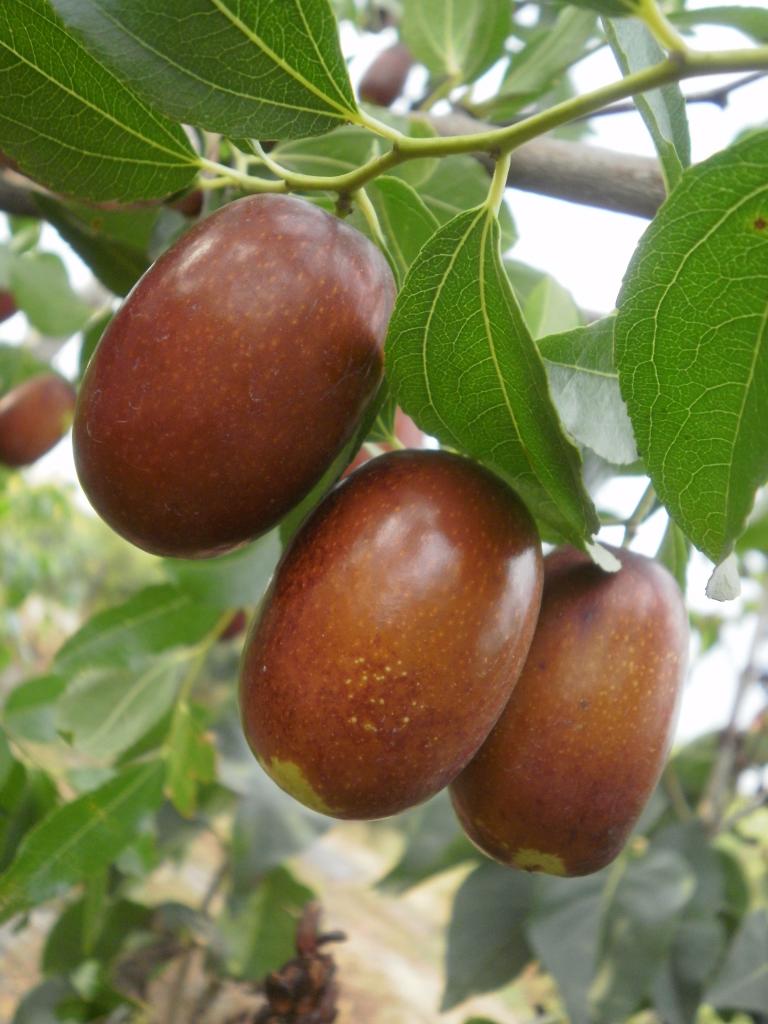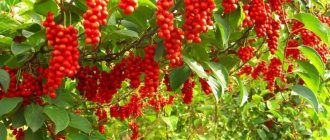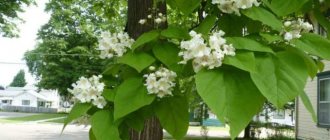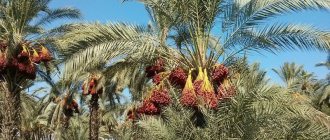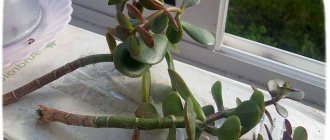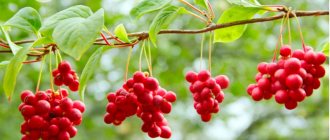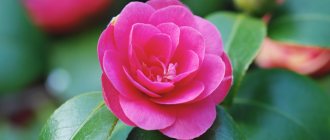The Chinese date Unabi is a beautiful plant that has many names: chillon, jujuba, breast berry, ziziphus, ilan jida, jojoba.
There are about 400 varieties of unabi. The birthplace of wild ziziphus is considered to be North China, Iran, India. On the territory of Russia, jujube grows wild in the North Caucasus.
Ziziphus combines many qualities that make it popular with gardeners... Unpretentiousness, decorativeness, high productivity, extremely useful properties of the fruits have led to the fact that unabis are willingly grown all over the world in climatic zones where summers are hot, dry, and winters are moderately cold. Southern Europe, some regions of Asia, America, northern Africa have the conditions necessary for the successful growth of Chinese dates, so the height of the unabi in those regions reaches 9 meters.
Zizyphus is also grown in central Russia, as well as in Ukraine, giving it the shape of a bush or a low tree no more than 3 meters high, as is known, for example, the Crimean Ziziphus. It is recommended to choose the earliest ripening varieties in order to plant it, for example, in the suburbs.
Botanical description
The Chinese date, ziziphus, jujuba, jujuba - as unabi are called in various languages - is a genus of deciduous and evergreen shrubs or medium-sized trees up to 10 m in height. Most wild and cultivated forms stretch up to 4-5 meters... The trunks are covered with thick wrinkled dark gray bark, the shoots are long and spreading, at a young age they are covered with sharp, hard spines. Cultivated varieties usually do not have thorns, but in the wild, they crumble when the trees reach 20-30 years of age. Unabi crowns are quite rare, although spreading, they do not give a thick shade... The root system is strong, with many branched shoots that penetrate deep into the soil. This ensures that plants are resistant to prolonged droughts.
The leaves are solid, dark green, smooth, ovoid, round or lanceolate, with pointed tips, small in size - about 4–5 cm long and 2.5–3 cm wide. They are arranged alternately on short petioles. The central and lateral veins are clearly visible on the leaf blades.... Foliage blooms late - in the middle or in the last days of May, when most of the plants are already entering the season of active vegetation.

Description of Unabi
Jojoba leaves grow alternately on thin green-brown shoots. The shoots end in spiny conical formations, so the unabi are shaped like spiky balls, reaching 3 - 4 meters in diameter.
The leaves are whole, with three characteristic veins, from 2 to 7 cm long. There are species that shed their leaves, there are evergreen species. Flowers resemble yellow stars with a green tint.
Ziziphus fruits resemble the fruit of a date palm in taste and density. The shape of the unabi fruit can be round or oval, slightly curved. The color is yellow-brown, red or black, depending on the variety.
Flowers and fruits
Flowers appear in early June. These are inconspicuous small five-petal stars of light green or white color. The plant is pollinated crosswise. The fruits ripen from mid-September to October. Spherical, oblong or pear-shaped fleshy drupes are collected in brushes.In wild unabis, they are similar to olives: no more than 1.5–5 cm in size. Garden forms are usually larger - about 3-5 cm. In structure and appearance, the fruits are similar to dates.... During the growth period, they are tough, light yellow. Mature ones have reddish-brown or brown skin, light, very juicy flesh with a soft fine-grained structure. In the middle of the fruit there is a thickened wide bone. Chinese dates taste sweet and sour.
The harvested crop is not stored for a long time, even in the refrigerator it begins to deteriorate after a week... Fresh unabis are recommended to be enjoyed right away. For the future, jams, compotes, preserves are prepared from them, canned or dried like dried apricots. In regions where Ziziphus is cultivated, the pulp of the ripe fruit is added to the bread dough to improve its quality. In national cuisines, unabis are baked, boiled, and juice is added to various dishes during the preparation process.


How to care for ziziphus?
With proper care, overseas jujube will grow and bear fruit well in our latitudes. A long-liver is able to please the owner with dates for a long time - Chinese ziziphus, growing and caring for it is not considered problematic, but requires attention. The activities that are needed for the southern plant are:
- timely watering;
- regular feeding;
- shelter in the winter;
- pruning to prevent crown thickening.
How to water ziziphus?
Proper watering of the unabi tree is the key to its health and long-term fruiting. In the southern regions of our country, after planting, the plant needs weekly irrigation. One bucket of water for each seedling is needed for good development. In the northern regions, watering a young Ziziphus tree is allowed once every two weeks. When the Chinese date is older, the watering can be reduced. An adult plant is watered once a month, trying to wet the soil to a depth of at least 60 cm.
Ziziphus graft
It is possible to plant another, more valuable variety on unabi, subject to certain rules. The wood of Ziziphus, a Chinese date, is tough and does not work with the usual grafting scheme. Experienced gardeners advise to carry out budding unabi according to the following scheme.
- Prepare a grafting stalk, the lower cut of which is cut at an angle of 45 °.
- Cut the same length at the top edge of the rootstock.
- Attach the sections to each other, press firmly and tie, and then process the junction with garden pitch.
- This grafting method is well suited for ziziphus, provided that the thickness of the scion and rootstock is the same.
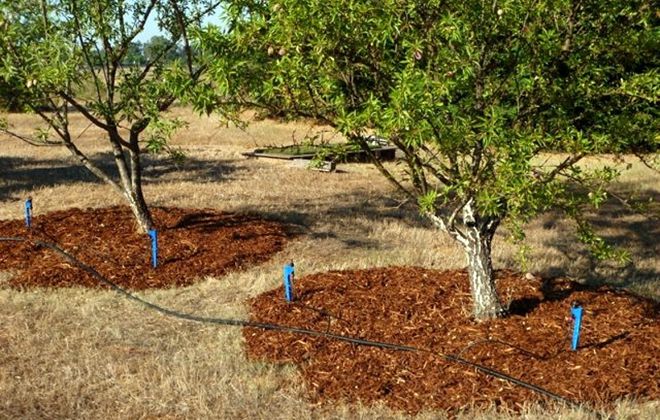

Composition and calorie content of fruits
Unabi fruits are valued for their delicate taste, fragrant aroma. Their pulp is saturated with sugars, vegetable fats, amino acids. It contains:
- ascorbic acid;
- B vitamins;
- vitamin E;
- carotene;
- citric, tartaric, malonic and other organic acids;
- minerals: iron, potassium, zinc, magnesium, calcium, iodine, phosphorus;
- triterpene glycosides;
- alkaloids;
- saponins;
- flavonoids;
- steroid compounds.
The energy value of fresh Chinese dates is about 80 kcal per 100 grams of product. This is twice as much as in apples or pears. Bananas and grapes contain approximately the same amount. The calorie content of dried fruits is about 350 kcal.


Unabi-ziziphus: what an exotic
For most of us, unabi is an exotic plant. However, in the East he has been known for a long time. According to some sources, in China and India, zizyphus was domesticated two thousand years ago. A little later, they began to grow it in Mediterranean countries. And only in the last century, the Chinese date began to grow in Uzbekistan, Turkmenistan, Transcaucasia, Krasnodar Territory, Crimea and southern Ukraine.
Unabi is the champion in terms of the number of titles. In different countries, he acquired not one, but several names at once.In total, there were about a dozen of them: ziziphus, zhuzhuba, juyuba, chapyzhnik, chailon, anab, chilion, jilan dzhida, planjiba, zao, yanap (or anab), arnap, ilan dzhida. In France, the plant is called breast berry, and in Russia, the Chinese date.


In China, unabi is called the tree of youth for the ability of its fruits and leaves to rid the body of toxins, cholesterol, cleanse blood vessels and strengthen capillaries
The native climate for unabi is the tropics and subtropics. For a long time it was believed that this plant does not survive and does not bear fruit in central Russia. But in recent years, more winter-hardy forms have appeared, and gardeners have adapted to growing thermophilic exotic species in a continental climate.
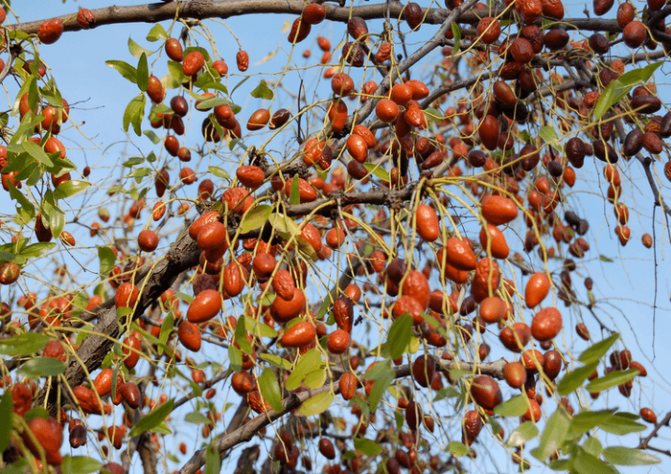

New cold-resistant forms of the subtropical Chinese date can also be grown in the middle lane
The Chinese date in culture is a small deciduous tree (up to 5 meters) or a tall shrub. On slightly drooping shoots, there may be rare thorns. Leaves are oval, with characteristic longitudinal veins. The crown is harmoniously shaped, pyramidal or spherical. Unabi is distinguished by a late start of the growing season. The plant wakes up by mid-May and even a little later. Therefore, return frosts are not afraid of him.
Most varieties of Ziziphus need cross-pollination, so 2-3 trees should be planted side by side to get a good harvest.
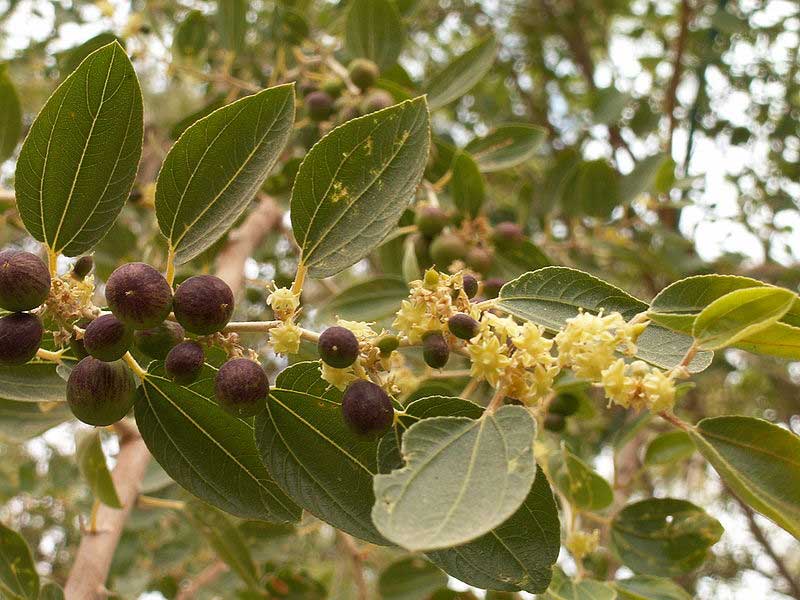

On the same branch, a ziziphus can have flowers and fruit ovaries.
Unabi bloom is extended, greenish-yellow flowers bloom for one and a half to two months. They're not very good looking, but they smell great. Bees find this smell very attractive. The fruits are tied and ripen unevenly: the former can ripen by the end of summer, the latter in October, or even in December. If the autumn is rainy, the harvest is harvested unripe, and the ripeness of the unabi picks up later; in dry autumn, gardeners recommend not to rush to harvest, but to let the fruits wither on the branches - then they become tastier. By the way, up to 25 kg of harvest can be removed from one adult tree, and there are record-breaking varieties that yield 80 kg each.


Most unabi varieties give high yields.
The fruits of different varieties of unabi differ significantly from each other. Their weight ranges from 2.5 to 35 grams. The shape can be spherical, oval, pear-shaped. Color from red-orange to chocolate brown. On the skin of some varieties, light specks are visible. Ripe fruits are tender and juicy. The pulp, sometimes mealy, sour and sweet tastes are combined in different variations. The stone is small, in some varieties it does not develop completely, remaining semi-soft.


Dried unabi fruits are very similar to real dates.
The Chinese date (or unabi) has nothing to do with the real date. The plant got its popular name due to the external similarity of the fruits and a slightly similar taste.
Unabi fruits are eaten fresh, they are used for making preparations (compotes, jam, syrup, candied fruits) or dried. In any form, Chinese dates are good for your health. They contain more ascorbic acid than citrus fruits, as well as flavonoids, pectin, carotene, rutin, iodine, cobalt and other elements.
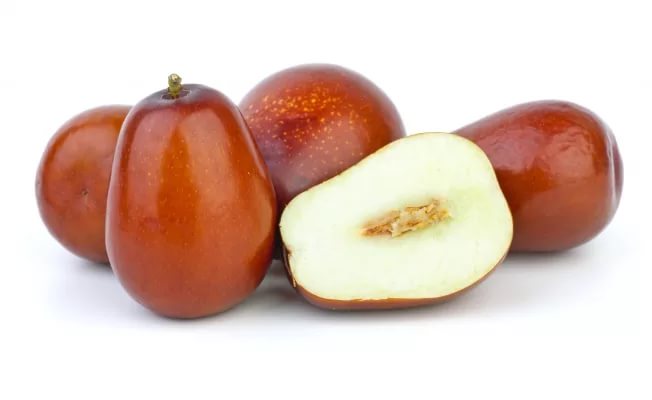

Fruits of different varieties differ in color and size, but are equally useful
Ziziphus fruits help with respiratory diseases, hypertension, anemia, vitamin deficiency. To lower blood pressure, Chinese doctors advise eating 20 fresh or dried dates three times a day after meals. The fruit decoction soothes and helps restore healthy sleep.
Birds can nibble on unabi crops. To protect it, a net is thrown over the trees.
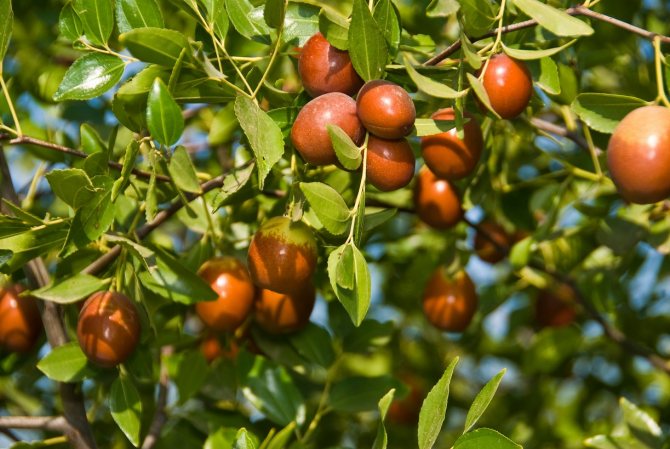

The sweet and sour fruits of the ziziphus resemble a date, pineapple and pear at the same time.
From the leaves of unabi, bark and roots (rich in tannins, saponins and rutin), healing agents are also prepared, which are used internally and externally.The broth has a diuretic, expectorant and antibacterial effect.
Video: why unabi (ziziphus) attracts gardeners
Healing properties
The rich vitamin, mineral composition, saturation with bioactive compounds makes unabi not only a valuable nutritious, but also a medicinal product. The fruits have antioxidant, anti-inflammatory, hypotensive, expectorant effects... They are recommended to be included in the diet with high blood pressure, upper respiratory tract diseases, atherosclerosis, liver and kidney pathologies. Fresh and dried Chinese dates, as well as jams and compotes from them:
- help with intoxication, fever, physical and nervous exhaustion;
- eliminate headaches;
- strengthen the immune system;
- normalize carbohydrate and fat metabolism;
- activate the work of the intestines, its peristalsis;
- relieve pregnant women from toxicosis;
- contribute to an increase in the amount of breast milk in nursing mothers.
Regular consumption of unabi is believed to rejuvenate the skin and may delay aging. For the same purpose, it is advised to make face masks from fresh pulp.


For medicinal purposes, not only the fruits are used, but also other parts of the ziziphus. Greens, ground seeds and tree bark are used in Chinese medicine. It is a powerful remedy for nervous disorders, insomnia, dermatological diseases, headache and toothache, stomatitis, inflammation of the kidneys and bladder. Bark infusion is used as a cosmetic to improve hair growth..
Eating
There are many recipes for unabi berries. There are simple, but there are also dishes that take time to prepare. Here is a partial list of the culinary uses of jojoba fruits:
- added when kneading the dough so that the baked bread stays fresh longer;
- served boiled with rice garnish;
- make jam and preserves based on sugar syrup;
- make pie filling;
- ziziphus is pickled, preparing conservation for the winter and used as snacks for alcoholic beverages;
- make tea, compote, jelly and other drinks.
Jojoba drink recipes
Most often, unabi fruits are used as a decoction, tea, although compotes are also cooked from the fruits. The most popular and quick recipes for making drinks from jojoba berries:
- Ziziphus tea. The drink is prepared in different ways, but the proportions are unchanged - you need to take 25-30 berries for 1 liter of water. Then you can do in two ways - grate the berries or mash with a fork. Pour boiling water over, boil covered for 8-10 minutes, drain.
- Decoction of fruits. This remedy can be used as medicine or drunk for pleasure. To prepare the broth, you will need 5 dried or fresh berries, which need to be filled with 2 tbsp. hot water. Place in a water bath and boil for half an hour. Let it brew for 1-2 hours, strain, squeeze the berries. Top up with boiled water to 400 ml. Drink half a glass three times a day 20-30 minutes before meals. An effective course of treatment is no more than 2 weeks.
- The benefits of dried apricots for weight loss
- How to increase blood pressure during pregnancy without medication
- Raw food diet for weight loss - diet menu with recipes for a week, feedback on the results
Contraindications
Without fear for your well-being, you can eat about 10 pieces of Chinese dates per day. This is enough to provide the body with useful compounds. With good tolerance, a larger amount will not harm a healthy person. However, you should not get carried away with tasty fruits, their excess causes intestinal upset.
For some health problems, unabi should be abandoned... They can damage with hypotension, high acidity of gastric juice, pancreatitis, cholelithiasis. In addition, these fruits are a potential allergen. Those who try them for the first time need to be careful: eat no more than 2-3 pieces at first. If there is no reaction from the body, you can increase the amount.


Should you grow Ziziphus?
The lack of hassle with leaving is far from the only quality that determined the popularity of the exotic plant among our gardeners. It is highly decorative and will adorn any garden. But this is not all the advantages that zizyphus has. The beneficial properties of this plant have earned him the reputation of a "superfood" and garden healer. And not only unabi berries are valued by humans. As a medicine, infusions and decoctions from its leaves and bark are used, and this raw material is easier to harvest if you have a miracle tree in your own garden.
Listing the healing properties of ziziphus, it is worth highlighting:
- normalization of blood pressure;
- improvement of the digestive tract, in particular the regulation of bowel emptying;
- relief of cough, sputum discharge;
- improving the condition of the skin and hair (when applied externally);
- prevention of anemia by increasing the level of iron in the blood;
- improving the functioning of the organs of the genitourinary system;
- increased potency in men;
- increased lactation in lactating women;
- prevention of heart problems;
- improving the condition of the liver.
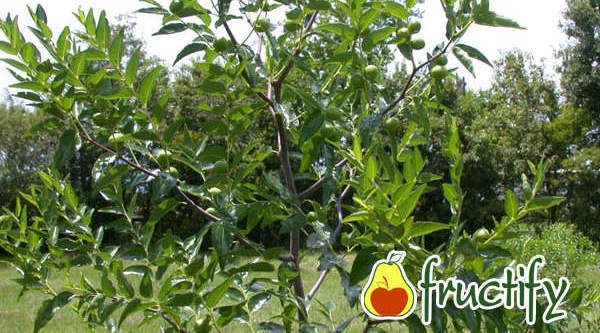

Benefits that Chinese unabi dates can bring, is invaluable. But harm from the plant is also possible, especially if you abuse it. Therefore, those who plan to grow the Crimean ziziphus on their site need not only to learn the peculiarities of caring for the plant, but also to study its useful properties and contraindications for use.
Advice: when it comes to exotic, unusual fruits for us, it is important not to forget that both benefits and harm are possible from them. Allergies to ziziphus and individual intolerance to the product cannot be ruled out. If you are prone to allergic reactions, it is worth starting "acquaintance" with the fruit with a minimum amount - one or two dates.
Unabi has many useful properties and has practically no contraindications for use. You should not eat berries for women during pregnancy, people with low blood pressure, allergy sufferers. The ban on the use of the product also applies to people with bowel problems, with a tendency to diarrhea.
Popular varieties
In total, there are almost 50 varieties of ziziphus. In culture, 3 types are most famous and widespread:
- Unabi Chinese or common (Ziziphus jujuba). In nature, it grows in the western territories of China. It is a spreading tree up to 6–8 m tall. The leaves are bright green, ovoid, elongated and pointed at the tips. Fruits are brown-brown, oval, large, 3.5–6 cm in size, weighing up to 45 g, ripen in September. Trees of this species can live up to 100 years, but bear fruit only up to 40 years of age. Fruiting is high: one specimen of an adult plant produces up to 50 kg of fruit per season.
- Lotus tree (Ziziphus lotus). Originally from the subtropics of the Mediterranean. Deciduous shrubs or small, branched trees with wide crowns. Leaves are light green, rounded, bloom in mid-May. Fruits are yellow, spherical, 2.5–4 cm in diameter, weighing 18–40 g, ripen at the end of September.
- Unabi Moorish (Ziziphus mauritiana). The African representative of the plant, differs from the Asian relatives in evergreen leaves, broadly ovate and elongated. Fruits are round, reddish or brown in color, about 3-5 cm in diameter.
In Russia and Ukraine, varieties of Chinese ziziphus are cultivated. This species is distinguished by the greatest cold resistance, does not die in frosty winters. Other species can only be grown as greenhouse crops.


Frost-resistant varieties of ziziphus
When it comes to the frost resistance of ziziphus, you need to understand that this is a relative concept. The varieties will have a satisfactory winter in the Crimea and the Caucasus, although they sometimes freeze there, but they quickly recover. By the way, compared to the Caribbean islands, this is a significant progress.
So in the suburbs or near Kiev, you should think carefully before planting an unabi. And choose varieties that grow with a bush so that they can be covered.
Ziziphus is considered a zone 6 plant, but it behaves differently in different regions. For example, in Azerbaijan, unabi withstands a short-term drop in temperature to -25 ° C without damage, in the steppe Crimea it freezes at -28 ° C, but in the same year it recovers and bears fruit. Annual zizyphus suffer the most - already in the second season after planting, they become much more stable.
You should not rush to throw away even a plant frozen to the root collar - it may well recover. Of course, this has nothing to do with the grafted varieties - the small-fruited species ziziphus will "fight off" from the root.
In any case, the unabi will freeze slightly. In the spring it is pruned, it quickly recovers and yields a harvest the same year.
Important! Small-fruited varieties of ziziphus have much greater frost resistance, some of them can be planted in the Moscow region, where they freeze slightly, but bear fruit.
Unabi varieties, the description of which is presented below, can be grown in the Krasnodar Territory, Rostov, Voronezh regions and on the Black Sea coast without shelter.
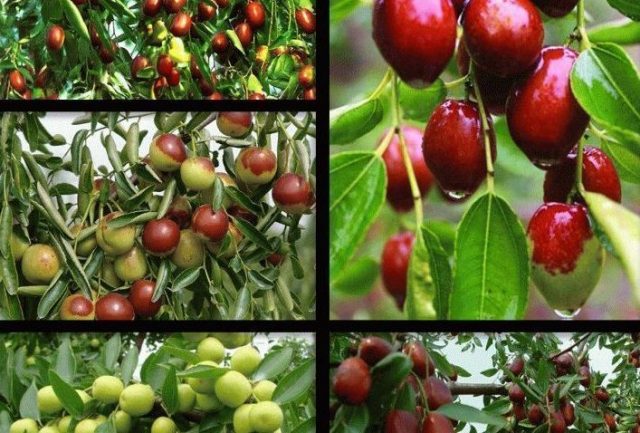

Koktebel
The ziziphus variety Koktebel was created by the Nikitsky Botanical Garden, adopted by the State Register in 2014. The authors are Sinko L.T. and Litvinova T.V. The variety was issued a patent No. 9974 dated 23.01.2019, the validity of which ends on 31.12.2049.
This is ziziphus of late ripening, universal use. Forms a medium-sized tree with a rounded crown and dark gray bark. The compactly spaced branches extend from the trunk at almost right angles. The dark green leaves of ziziphus are large, smooth and shiny, ovoid.
Large rounded fruits of the Koktebel variety unabi have an average weight of about 32.5 g. The lumpy peel is shiny, covered with dots, after full ripening it becomes light brown. Sweet and sour creamy, mealy pulp. Ziziphus Koktebel bears fruit annually, giving from a centner to 187 centners.
The variety tolerates high temperatures well. Transportability, drought and frost resistance of ziziphus are average.
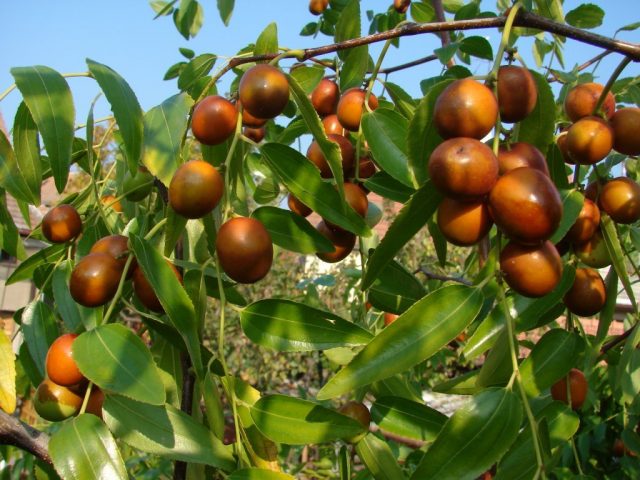

Plodivsky
The Ziziphus variety Plodivsky was created in the Novokakhovskoye Experimental Farm (Ukraine), adopted by the State Register in 2014. Recommended for growing in the North Caucasus region.
Ziziphus Plodivsky forms a medium-sized tree with few thorns. Young skeletal branches are long, grayish brown, fruit shoots are creamy green, easy to distinguish.
Fruits are small, oval in shape, with a brown skin, greenish-white pulp, a little juice. The yield of the variety from 1 hectare is 95 centners, the ripening period is average.
Resistance to drought and low temperatures unabi Plodivsky - high.
Sinit
The Ziziphus variety Sinit, adopted by the State Register in 2014, was created by the Nikitsky Botanical Garden. It was issued a patent No. 9972 dated 23.01.2019, which will expire on 31.12.2049.
Fresh fruits of this variety of ziziphus received a tasting score of 5 points and have a dessert purpose. A tree of medium height with dark gray bark and a rounded crown forms skeletal branches set at right angles to the trunk. Unabi leaves are oval, small, dark green.
Fruits are round-elongated, with a thin dark brown skin. The pulp, devoid of aroma, is dense and juicy, creamy, sweet and sour. Productivity - 165 kg / ha.
Without damage, the variety can withstand frosts down to -12.4 ° C. Unabi Sinit tolerates heat well, drought is medium.
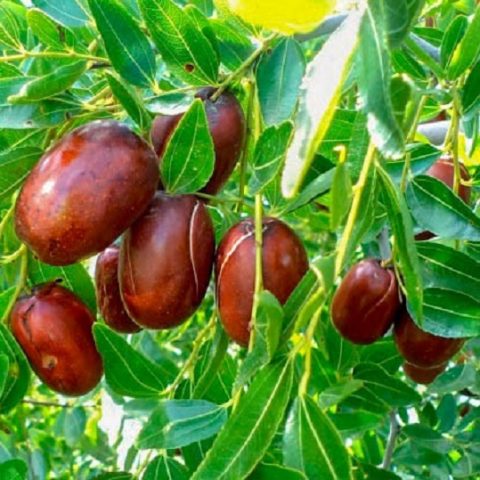

Tsukerkovy
Ziziphus variety, the name of which is translated from Ukrainian as "candy", was adopted by the State Register in 2014. Created by the staff of the Nikitsky Botanical Garden Sinko L. T., Chemarin N. G., Litvinova T. V. Protective patent No. 9973 issued and expires at the same time as the varieties of ziziphus Koktebel and Sinit.
Unabi Tsukerkovy has an early ripening period and a dessert taste, estimated at 5 points. Forms a medium-sized tree with branches growing at right angles. Dark green, ovate-elongated leaves are small.
Medium-sized oblong-rounded fruit, with a shiny dark brown skin and sweet and sour juicy pulp, no aroma. The yield of the variety is up to 165 centners per hectare.


Yalita
A new variety of unabi, a patent for which was issued earlier (No. 9909 dated 11/12/2018) than it was adopted by the State Register in 2020. The authors were Sinko L.T. and Chemarin N.G.
Ziziphus variety Yalita is very early, universal, its taste is estimated at 4.9 points. A tree of medium height forms a dense, ascending crown with reddish-brown branches pointing upwards at an acute angle to the trunk. Ovate leaves are large, with a sharp top and a round base.
The fruits are large, in the form of an elongated cylinder, with a brown smooth skin. The pulp is firm, sweet and sour, yellowish. Productivity - up to 107.6 centners per hectare.
Landing
Outdoors, unabi grows well in hot, subtropical climates. It easily tolerates periods of prolonged drought, temperatures above +30 ° C. For planting, you should choose elevated areas, direct sunlight is not terrible for this plant. The soil is recommended to be loose, neutral, of moderate fertility. Chinese dates do not like heavy, sour, weeping soils.
In temperate climates, ziziphus should be planted in glass greenhouses near the walls of houses. This will allow you to accumulate heat and preserve the culture in severe frosts.
It is recommended to choose seedlings in the nursery for their climatic zone. Bushes brought from the tropics will die in the middle lane... Unabi should be planted in spring, when the soil temperature warms up to 12 ° С, and the air temperature - up to 15-17 ° С.
In order to have hope of waiting for a good harvest, it is recommended to plant not one, but several trees at once. This will provide the necessary cross-pollination.
Root holes are dug with a depth and width of about half a meter. The removed soil is mixed with rotted compost and the pits are filled up to half. The seedlings are placed in loose soil, gently spreading the roots, and covered with the remaining soil. The root collars should be flush with the surface. Immediately after planting, the plants are watered with scattered jets of water from a watering can: 10 liters per seedling.
Mineral dressing and manure cannot be applied during planting - this can burn the delicate roots.


Growing and caring for a Chinese date
Ziziphus is thermophilic, drought-resistant and is capable of producing crops only in a well-lit area. The tree feels great even at + 50 ° C. In the conditions of the southern regions of the Russian Federation, jujuba will grow even in dry areas where grapes do not survive. Although watering and fertilizing with mineral fertilizers will only benefit the plant. The Chinese date is undemanding to the composition of the soil, but does not like highly saline and heavy soils.
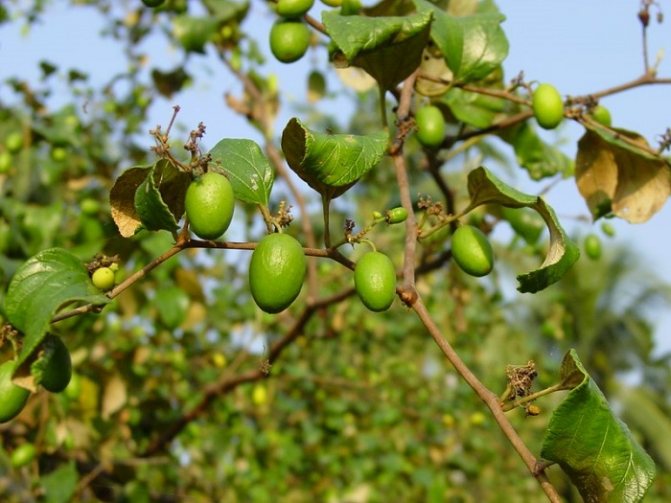

The culture tolerates heat and lack of moisture well
In spring, the tree is planted in flat areas, as well as in the upper or lower part on the southern or southwestern slope. Deepen the seedlings by 10 cm. There should be at least 2 m between them. In warm regions, grow a jujuba in the form of a tree. In places where the soil may freeze in winter - in the form of a bush.
Zizyphus is resistant to diseases and insect pests. The plant needs to be badly run in order for it to become infected with a fungus or a virus. But the birds can be flattered by the harvest. Therefore, you need to either scare them away, or collect ripe fruits faster.
Care features
Plants in the first two years of life are watered twice a month. But only in dry hot weather. With frequent rains, unabi does not require additional moisture. Excess water can cause root rot... Adult trees practically do not need water from the outside, root shoots get the necessary moisture from the depths.
Young trees can suffer from weeds, they must be carefully weeded out, and the soil must be loosened weekly. To facilitate maintenance, it is advisable to mulch the trunks with sawdust, needles or dry foliage.
In the second year, seedlings can be fertilized. In the spring, a mixture of 3 kg of humus, 20 g of superphosphate, 15 g of ammonium nitrate and 10 g of potassium salt is prepared for 1 m² of soil. The dry substrate is scattered in an even layer around the roots, slightly embedded in depth, then the soil is watered. A single fertilization is enough for plants.
Due to frequent frosting in the temperate zone, the Chinese date grows rather slowly, forming not trees, but shrub forms. Every year, dying shoots should be removed, and thickened crowns should be thinned out.
Varietal crops begin to bear fruit 3-4 years after planting... Wild birds develop more slowly, you can expect fruits from them in 5-6 years.


Features of planting ziziphus
The Chinese date is thermophilic. In cool climates, the tree will also grow, but it is unlikely to bear fruit even in a greenhouse. And in the open air, severe cold can freeze the culture to the roots, but the tree will not die and will recover quickly enough. The growing season for unabi begins in April or May. In some years it may fluctuate due to the weather situation.
Flowering falls in the summer and can last up to 3 months. The culture prefers cross-pollination. Therefore, a representative of a different variety must grow nearby. Fruiting occurs in the 2-3 season of life in the garden. At this age, the yield is 10-16 c / ha. Over time, the tree's fertility continues to grow until it reaches 150-300 centners.
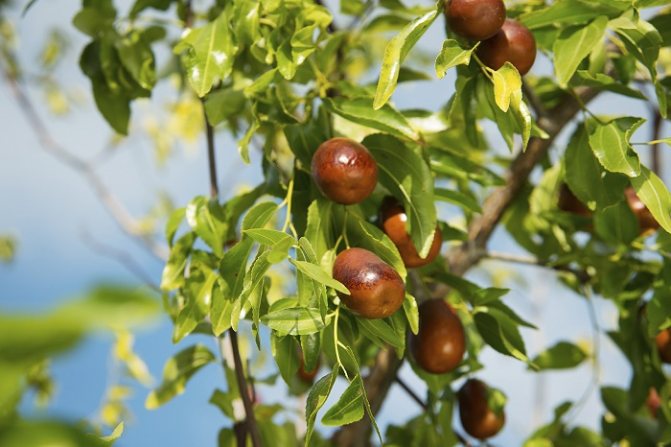

Unabi tree
Ziziphus is grown from seeds or cuttings. Seed propagation is relevant only for small-fruited varieties. In species with large fruits, seeds have poor germination. For planting:
- Pick well-ripe fruits.
- Remove the pulp.
- Warm up the seeds and bones. To do this, put them in the sun or keep them in warm water (60 ° C).
- Within 1 month. make a warm stratification for the material (20-35 ° С).
- Preheat the soil: pour it over with warm water and cover with foil.
- Close the bones 3-4 cm and again cover the ground with foil.
- After about 20 days, seedlings will appear in the ground. Transfer each one to an individual container.
- The jujuba will be ready for rooting in a permanent place in a season.
Advice. Before planting the seed, gardeners advise you to lightly hit the bone with a hammer. Then it will be easier for the germ to break through the dense shell.
Seed-grown Chinese date trees will have no varietal traits, will bloom later, and will be less fertile than their parents. Such samples are usually grafted to correct these deficiencies. Chinese date rootstocks are also grown using root cuttings. Select samples of at least 8-12 cm and plant them flush with the ground.
You can also graft a seedling of a plant with a bud - to carry out budding. The rootstocks should be 6-10 mm in diameter at the root. The bud can be either dormant (late summer) or sprouting (May). Graft it with a side wedge for the bark or in a side incision.
Wintering
For unabis growing in temperate latitudes, wintering is a sore subject. The culture can tolerate short-term frosts down to –30 ° С, but long-term cold weather can be destructive for it. Good shelter helps to preserve the root collar, and instead of freezing shoots, new ones grow in summer.
For the winter, the soil around the roots is covered with a thick layer of mulch, the branches are bent to the ground, secured with wire or staples. Cover with burlap on top. With the onset of heat, the shelter is removed and the crowns are examined. Determining whether a plant has died or not is immediately difficult due to late vegetation. The viability of the unabi is determined by cutting off a small section of the shoot in May. The branches that are blackened inside are cut off.
Ziziphus at home
Winter gardens, insulated verandas, spacious loggias can be decorated with homemade ziziphus that grows in a pot. Having received an unabi seedling in any way, you can plant it in a pot and grow the plant at home, observing the rules.
- Ziziphus, a Chinese date, needs replanting every year until the tree is 5 years old. After that, the tree is renewed its place of residence every 3-4 years, necessarily keeping an earthen lump, and increasing the pot by 10-15 cm.
- The sunniest place in the house is best for the unabi.
- Feeding with phosphate complexes is considered the most optimal. From April to the end of summer, the plant can be fertilized once a month.
- The air temperature for wintering home dates is from 5 to 10 ° C warm.
- In summer, the tree can be taken out into the garden or on the veranda.
- Drying out of an earthen coma for a plant is unacceptable, watering in summer should be moderate, and in winter - minimal.
Reproduction
Wild Zizphus species can be germinated from seeds. Garden forms are propagated by layering, root suckers or grafting. All methods are quite troublesome and time-consuming.
It is advisable to immediately plant the bones in a permanent place.... Growing and subsequent transplanting seedlings carry a greater risk of crop death. The material is laid in the soil in the fall: in October or November, deepening by 4–5 cm. Wood chips or needles are poured on top. During the winter, the seeds will undergo stratification, and in the spring they will start to grow.


An adult plant is easier to propagate by root appendages. In May or June, it is enough to dig them up on the side of the trunk and carefully detach them, transferring them to a new place.
Another way to breed unabi is by rooting layers.... The lateral branch is bent down in the spring, after making several small cuts on the bark. At the site of the cut, fix it to the soil and sprinkle it with soil. The top is left open. All summer long, the cuttings are looked after by regularly watering and clearing the rooting site of weeds. In autumn, the shoot can be cut off from the donor plant.
Reproduction by root cuttings gives a good result.... For this purpose, in adult ziziphus, a horizontal shoot of at least 1 cm thick is excavated and cut off. It is cut into pieces 10-15 cm long, which are planted in containers with moist soil. After a few weeks, young shoots will begin to grow from the dormant buds. They are nursed throughout the season and winter, and the next summer they are planted in a permanent place.
Complex methods of culture propagation: grafting and budding... In the first case, a lignified stalk of the desired variety is attached to the scion - an adult developing plant. In the second, a T-shaped incision is made in the stem of the scion and a healthy bud of a new plant is placed in it. The joints are sealed with a special tape.
Features of growing ziziphus
Many believe that the Chinese date is an exclusively southern exotic and cannot be grown in a temperate climate. In fact, as practice shows, it copes well with the weather in Voronezh, for example. True, it grows so far only in the gardens of amateur gardeners, which is a pity. In addition to medicinal properties, which will be discussed later, modern varieties of ziziphus have large oblong drupes (sizes up to 3x5 cm) with a peculiar sour-sweet taste.
It is not difficult to grow ziziphus in your area. It has a very powerful, deeply and widely spreading root system. Due to this, the plant is able to easily tolerate drought, undemanding to soil and fertilizers. Probably, it is not worth growing it only where the groundwater is too high.
At my site, I regularly watered ziziphus only for the first season, while the small seedling took root. Then, I gave up this business, it grows for itself and bears fruit from the second year. True, it is believed that with watering the harvest is still larger and better.
Ziziphus grows from 3 to 8 meters in height, with curved, reddish young branches, over time the bark turns gray.Leaves are oval, leathery, shiny, bright green, pleasant to the eyes, about 5 cm long.
But the flowers are pale yellow and very small, collected in small inflorescences of 3-6 pieces. Ziziphus blooms from mid-June to mid-August, so no frost is terrible for the flowers.
In winter, at rest, ziziphus calmly withstands frost down to -25 degrees, however, if you have a young grafted seedling, then in the first winter it is worthwhile to play it safe and either spud the grafting site with earth, or completely cover the seedling by making an air-dry shelter.
To do this, you need to build a rigid frame (put, for example, a large plastic bottle without a bottom) and cover it with earth or dry leaves. But, I repeat, this is already an extreme case, if you have severe frosts, and the ziziphus sapling is still small. In subsequent years, the need for shelter disappears.


Ziziphus grows from 3 to 8 meters in height. <степан>
Ziziphus formation
Ziziphus can be formed in different ways. Someone likes a bush, but someone likes a tree. If you decide to grow like a tree, then regularly remove all the shoots on the trunk, at a height of about 50-70 cm and leave 4-5 skeletal branches, which are evenly distributed in different directions.
In addition, thickening shoots growing inside the crown are regularly removed, and sanitary pruning is done in the spring.
Diseases and pests of ziziphus
He has not yet found any pests or diseases on the ziziphus, which means that he does not need to carry out any chemical treatments. Why is this good? That's right, environmentally friendly and healthy products.
Pests and diseases
Unabi is a rare plant. It does not lend itself to attack by specific parasites or diseases. An actual problem that it may face is cracking of the skin of unripe fruits. This is due to the uneven moisture regime when watering is plentiful. Another problem is fruit decay. Waterlogging or fungal infection may be the culprit.... The way out is correction of the water regime and treatment of crowns with fungicides. Sick fruits are cut off and destroyed.
Saplings brought from the south may show viral spotting or the so-called witch's brooms.... In the first case, the leaves are covered with whitish stains. There are no methods of treatment, diseased plants can only be destroyed. Broomsticks are called bundle growths of short branches. You can get rid of them by regularly cutting out the affected areas.
Features of fruiting and preparation for winter
Fruiting of the culture begins 2 years after planting. The plant is characterized by sweet or sour fruits. They combine a large number of unique ingredients.
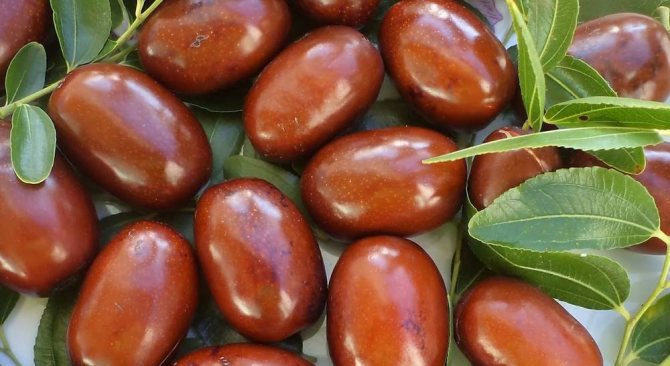

The date has an excellent yield.
Dates contain trace elements, ascorbic acid, ingredients with P-vitamin activity. Thanks to the use of this product, it is possible to normalize pressure and make blood vessels more elastic.
The resistance of a plant to frost depends on its variety. In the early years, all types of culture need to be covered. To do this, you need to spud the planting and cover it with non-woven material. Harboring more mature cultures is very problematic.
Important! Slight freezing of shoots usually does not affect the yield parameters. In the spring, it is necessary to cut off all affected branches.

